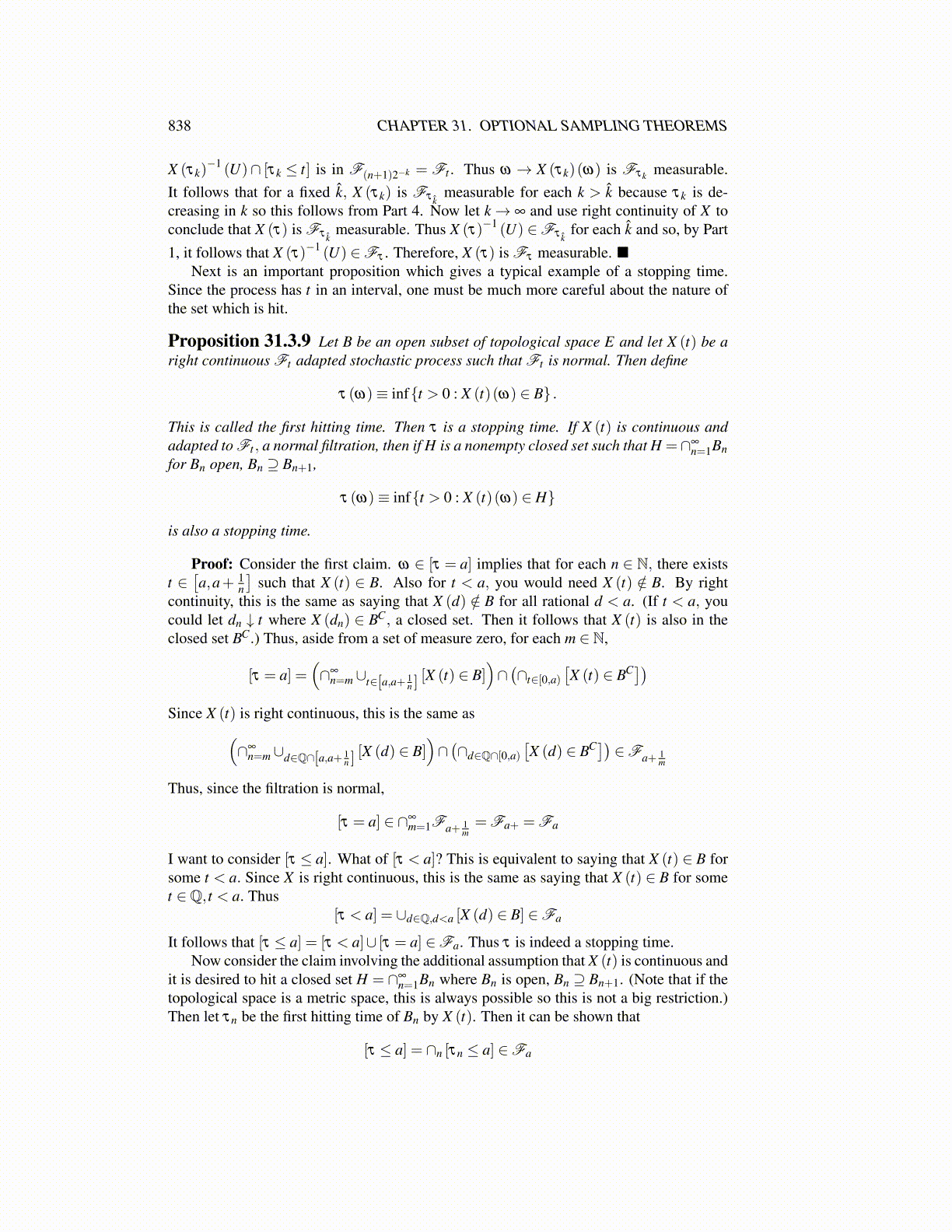
838 CHAPTER 31. OPTIONAL SAMPLING THEOREMS
X (τk)−1 (U)∩ [τk ≤ t] is in F(n+1)2−k = Ft . Thus ω → X (τk)(ω) is Fτk measurable.
It follows that for a fixed k̂, X (τk) is Fτ k̂measurable for each k > k̂ because τk is de-
creasing in k so this follows from Part 4. Now let k→ ∞ and use right continuity of X toconclude that X (τ) is Fτ k̂
measurable. Thus X (τ)−1 (U) ∈Fτ k̂for each k̂ and so, by Part
1, it follows that X (τ)−1 (U) ∈Fτ . Therefore, X (τ) is Fτ measurable. ■Next is an important proposition which gives a typical example of a stopping time.
Since the process has t in an interval, one must be much more careful about the nature ofthe set which is hit.
Proposition 31.3.9 Let B be an open subset of topological space E and let X (t) be aright continuous Ft adapted stochastic process such that Ft is normal. Then define
τ (ω)≡ inf{t > 0 : X (t)(ω) ∈ B} .
This is called the first hitting time. Then τ is a stopping time. If X (t) is continuous andadapted to Ft , a normal filtration, then if H is a nonempty closed set such that H =∩∞
n=1Bnfor Bn open, Bn ⊇ Bn+1,
τ (ω)≡ inf{t > 0 : X (t)(ω) ∈ H}
is also a stopping time.
Proof: Consider the first claim. ω ∈ [τ = a] implies that for each n ∈ N, there existst ∈[a,a+ 1
n
]such that X (t) ∈ B. Also for t < a, you would need X (t) /∈ B. By right
continuity, this is the same as saying that X (d) /∈ B for all rational d < a. (If t < a, youcould let dn ↓ t where X (dn) ∈ BC, a closed set. Then it follows that X (t) is also in theclosed set BC.) Thus, aside from a set of measure zero, for each m ∈ N,
[τ = a] =(∩∞
n=m∪t∈[a,a+ 1n ][X (t) ∈ B]
)∩(∩t∈[0,a)
[X (t) ∈ BC])
Since X (t) is right continuous, this is the same as(∩∞
n=m∪d∈Q∩[a,a+ 1n ][X (d) ∈ B]
)∩(∩d∈Q∩[0,a)
[X (d) ∈ BC]) ∈Fa+ 1
m
Thus, since the filtration is normal,
[τ = a] ∈ ∩∞m=1Fa+ 1
m= Fa+ = Fa
I want to consider [τ ≤ a]. What of [τ < a]? This is equivalent to saying that X (t) ∈ B forsome t < a. Since X is right continuous, this is the same as saying that X (t) ∈ B for somet ∈Q, t < a. Thus
[τ < a] = ∪d∈Q,d<a [X (d) ∈ B] ∈Fa
It follows that [τ ≤ a] = [τ < a]∪ [τ = a] ∈Fa. Thus τ is indeed a stopping time.Now consider the claim involving the additional assumption that X (t) is continuous and
it is desired to hit a closed set H = ∩∞n=1Bn where Bn is open, Bn ⊇ Bn+1. (Note that if the
topological space is a metric space, this is always possible so this is not a big restriction.)Then let τn be the first hitting time of Bn by X (t). Then it can be shown that
[τ ≤ a] = ∩n [τn ≤ a] ∈Fa